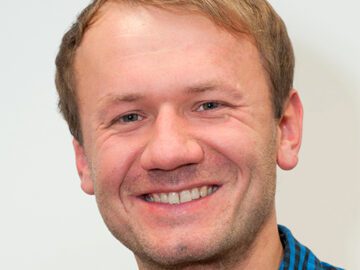Jaroslaw Dankert
PD Dr. rer. nat., AOR
neé: Szczyrba
Das Prostatakarzinom ist weltweit immer noch eine der häufigsten diagnostizierten Tumorarten bei Männern und ist aufgrund der hohen klinischen Relevanz ein Schwerpunkt der Tumorforschung. Die Ursachen für die Entstehung dieser Tumorentität sind noch nicht vollständig geklärt, jedoch konnte die Fehlexpression bekannter Onkogene und Tumorsuppressoren sowie nicht-kodierender RNAs beobachtet werden. Der Forschungsschwerpunkt von Dr. Dankert liegt auf der Untersuchung grundlegender Expressionsänderungen proteinkodierender Gene und verschiedener nicht-kodierender RNA-Spezies im Prostatakarzinom sowie ihrer Charakterisierung. Hierbei möchte er neue Gene sowie RNAs identifizieren, die einen Einfluss auf die Entstehung und Progression dieser Tumorentität haben, um weitere Ansatzpunkte für zukünftige Therapien zu finden sowie mögliche Diagnostikverbesserungen zu erhalten.
Im Labor kommen eine Vielzahl von Methoden aus der Molekularbiologie, Proteinbiochemie und Zellbiologie zum Zuge. Dazu gehören Klonierungen von Genen, Reportergenassays, Expressionsanalysen mittels qRT-PCR, Micro Arrays oder Deep Sequencing, Zellkultur-basierte funktionelle Untersuchungen von Genkandidaten. Neben dieser in vitro Methoden werden zusätzlich in situ Analysen wie z.B. Immunfluoreszenz- sowie immunhistologische Färbungen von Gewebe sowie RNA-ISH durchgeführt.
Prostate carcinoma is still one of the most commonly diagnosed cancers in men worldwide and stays in the focus of cancer research due to its high clinical relevance. The genesis for this tumor entity hasn’t been fully clarified yet, though a deregulated expression of oncogenes and tumor suppressors as well as non-coding RNAs are described. The focus of Dr. Dankert lies on the analysis of expression changes concerning protein-coding genes as well as non-coding RNA species and their functions in prostate carcinoma. Here, he wants to identify new genes and RNAs, which have an impact on tumorigenesis and progression, aiming at new therapy starting points and improvement of diagnostics.
For this, a multitude of methods from molecular biology, protein biochemistry and cell biology is used. They include gene cloning, reporter gene assays, expression analysis by qRT-PCR, micro arrays and deep sequencing as well as cell-based functional analyses of candidate genes. Beside in vitro methods, Dr. Dankert also performs in situ analysis such as IF and IHC stainings or RNA-ISH.
Latest Publications
Czyrnik, ED, Wiesehöfer, M, Dankert, JT, Wach, S, Wagner, M, Spahn, M, Kruithof de Julio, M, Wennemuth, G (2023). Stromal-epithelial interaction induces GALNT14 in prostate carcinoma cells. Front Oncol13,1212585.
Wiesehöfer, M, Raczinski, BBG, Wiesehöfer, C, Dankert, JT, Czyrnik, ED, Spahn, M, Kruithof-de Julio, M, Wennemuth, G (2023). Epiregulin expression and secretion is increased in castration-resistant prostate cancer. Front Oncol13,1107021.
Frintrop, L, Wiesehöfer, C, Stoskus, A, Hilken, G, Dubicanac, M, von Ostau, NE, Rode, S, Elgeti, J, Dankert, JT, Wennemuth, G et al. (2022). cAMP and the Fibrous Sheath Protein CABYR (Ca2+-Binding Tyrosine-Phosphorylation-Regulated Protein) Is Required for 4D Sperm Movement. Int J Mol Sci23,.
Wiesehöfer, C, Wiesehöfer, M, Dankert, JT, Chung, JJ, von Ostau, NE, Singer, BB, Wennemuth, G (2022). CatSper and its CaM-like Ca2+ sensor EFCAB9 are necessary for the path chirality of sperm. FASEB J36,e22288.
Busch, M, Miroschnikov, N, Dankert, JT, Wiesehöfer, M, Metz, K, Stephan, H, Dünker, N (2021). Impact of RARα and miR-138 on retinoblastoma etoposide resistance. Tumour Biol43,11-26.
Wiesehöfer, M, Czyrnik, ED, Spahn, M, Ting, S, Reis, H, Dankert, JT, Wennemuth, G (2021). Increased Expression of AKT3 in Neuroendocrine Differentiated Prostate Cancer Cells Alters the Response Towards Anti-Androgen Treatment. Cancers (Basel)13,.
Dankert, JT, Wiesehöfer, M, Wach, S, Czyrnik, ED, Wennemuth, G (2020). Loss of RBMS1 as a regulatory target of miR-106b influences cell growth, gap closing and colony forming in prostate carcinoma. Sci Rep10,18022.
Czyrnik, ED, Wiesehöfer, M, Dankert, JT, Wennemuth, G (2020). The regulation of HAS3 by miR-10b and miR-29a in neuroendocrine transdifferentiated LNCaP prostate cancer cells. Biochem Biophys Res Commun523,713-718.
Dankert, JT, Wiesehöfer, M, Czyrnik, ED, Singer, BB, von Ostau, N, Wennemuth, G (2018). The deregulation of miR-17/CCND1 axis during neuroendocrine transdifferentiation of LNCaP prostate cancer cells. PLoS One13,e0200472.
Szczyrba, J, Jung, V, Beitzinger, M, Nolte, E, Wach, S, Hart, M, Sapich, S, Wiesehöfer, M, Taubert, H, Wennemuth, G et al. (2017). Analysis of Argonaute Complex Bound mRNAs in DU145 Prostate Carcinoma Cells Reveals New miRNA Target Genes. Prostate Cancer2017,4893921.
Search PubMed
